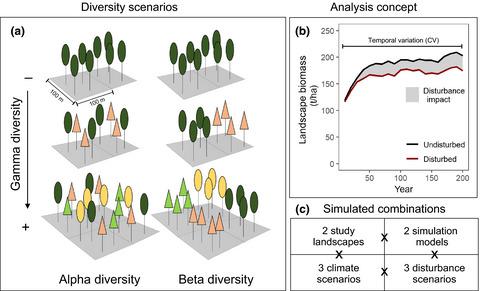当前位置:
X-MOL 学术
›
J. Appl. Ecol.
›
论文详情
Our official English website, www.x-mol.net, welcomes your feedback! (Note: you will need to create a separate account there.)
Mixing tree species at different spatial scales: The effect of alpha, beta and gamma diversity on disturbance impacts under climate change
Journal of Applied Ecology ( IF 5.7 ) Pub Date : 2021-05-17 , DOI: 10.1111/1365-2664.13912 Julius Sebald 1, 2 , Timothy Thrippleton 3, 4 , Werner Rammer 2 , Harald Bugmann 3 , Rupert Seidl 1, 2, 5
中文翻译:

不同空间尺度的混合树种:气候变化下α、β和γ多样性对干扰影响的影响
更新日期:2021-05-17
Journal of Applied Ecology ( IF 5.7 ) Pub Date : 2021-05-17 , DOI: 10.1111/1365-2664.13912 Julius Sebald 1, 2 , Timothy Thrippleton 3, 4 , Werner Rammer 2 , Harald Bugmann 3 , Rupert Seidl 1, 2, 5
Affiliation

|
- Single species forest systems often suffer from low resistance and resilience to perturbations. Consequently, fostering tree species diversity is discussed as an important management approach to address the impacts of changing climate and disturbance regimes. Yet, the effect of the spatial grain of tree species mixtures remains unknown.
- We asked whether increasing tree species diversity between stands (beta diversity) has the same effect as increasing tree species diversity within stands (alpha diversity) at similar overall levels of richness (gamma diversity). We conducted a multi-model simulation experiment under climate change, applying two forest landscape models (iLand and LandClim) across two contrasting landscapes of Central Europe. We analysed the effect of different levels and configurations of diversity on the disturbance impact and the temporal stability of biomass stocks and forest structure.
- In general, increasing levels of diversity decreased disturbance impacts. Positive diversity effects increased with increasing severity of climate change. Beta diversity buffered disturbance impacts on landscape-level biomass stocks more strongly than alpha diversity. The effects of the spatial configuration on forest structure were more variable. Diversity effects on temporal stability were less pronounced compared to disturbance impacts, and mixture within and between stands had comparable effects on temporal stability.
- Diversity effects were context-dependent, with patterns varying between landscapes and indicators. Furthermore, we found a strong species identity effect, with increasing diversity being particularly beneficial in conifer-dominated systems of the European Alps. The two models agreed on the effects of different levels and configurations of tree species diversity, underlining the robustness of our findings.
- Synthesis and application. Enhancing tree species diversity can buffer forest ecosystems against increasing levels of perturbation. Mixing tree species between stands is at least as effective as mixing tree species within stands. Given the managerial advantages of between-stand mixtures (e.g. reduced need to control competition to maintain diversity, higher timber quality, lower logistic effort), we conclude that forest management should consider enhancing diversity at multiple spatial scales.
中文翻译:

不同空间尺度的混合树种:气候变化下α、β和γ多样性对干扰影响的影响
- 单一物种森林系统通常对扰动的抵抗力和恢复力较低。因此,培育树种多样性被认为是应对气候变化和干扰机制影响的重要管理方法。然而,树种混合物的空间粒度的影响仍然未知。
- 我们询问增加林分之间的树种多样性(β 多样性)是否与增加林分内树种多样性(阿尔法多样性)在相似的总体丰富度水平(伽马多样性)下具有相同的效果。我们在气候变化下进行了多模型模拟实验,将两个森林景观模型(iLand 和 LandClim)应用于中欧两个对比鲜明的景观。我们分析了不同层次和多样性配置对生物量库和森林结构的干扰影响和时间稳定性的影响。
- 一般而言,多样性水平的提高降低了干扰影响。积极的多样性影响随着气候变化严重程度的增加而增加。Beta 多样性缓冲干扰对景观级生物量储量的影响比 alpha 多样性更强。空间配置对森林结构的影响变化更大。与干扰影响相比,多样性对时间稳定性的影响不那么明显,林分内和林分之间的混合对时间稳定性的影响相当。
- 多样性影响取决于环境,景观和指标之间的模式各不相同。此外,我们发现了强烈的物种同一性效应,在欧洲阿尔卑斯山以针叶树为主的系统中,多样性的增加尤其有益。这两个模型同意树种多样性不同水平和配置的影响,强调了我们研究结果的稳健性。
- 合成与应用。增强树种多样性可以缓冲森林生态系统免受日益增加的扰动。在林分之间混合树种至少与在林分内混合树种一样有效。鉴于林间混合物的管理优势(例如减少控制竞争以保持多样性的需要、更高的木材质量、更低的后勤工作),我们得出结论,森林管理应考虑在多个空间尺度上增强多样性。

























 京公网安备 11010802027423号
京公网安备 11010802027423号